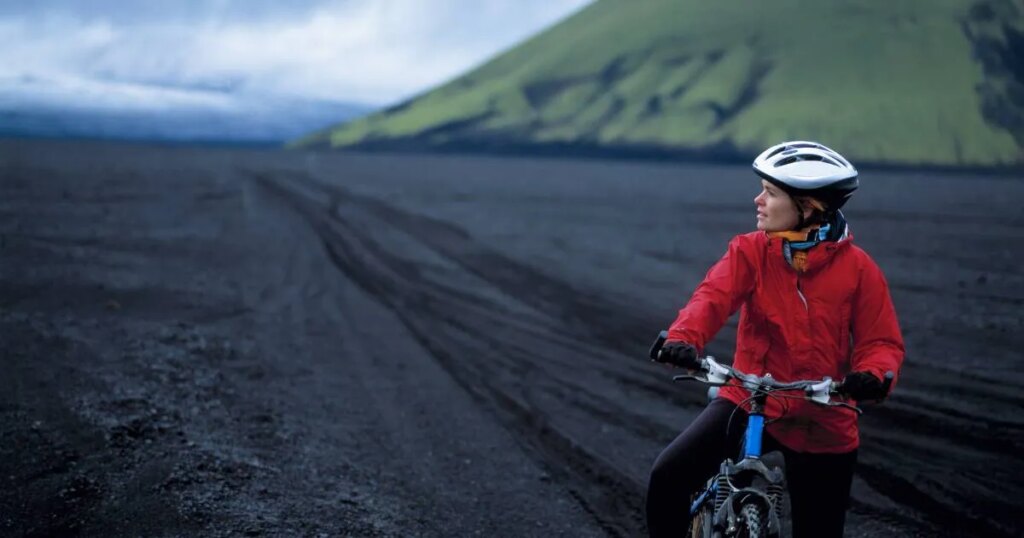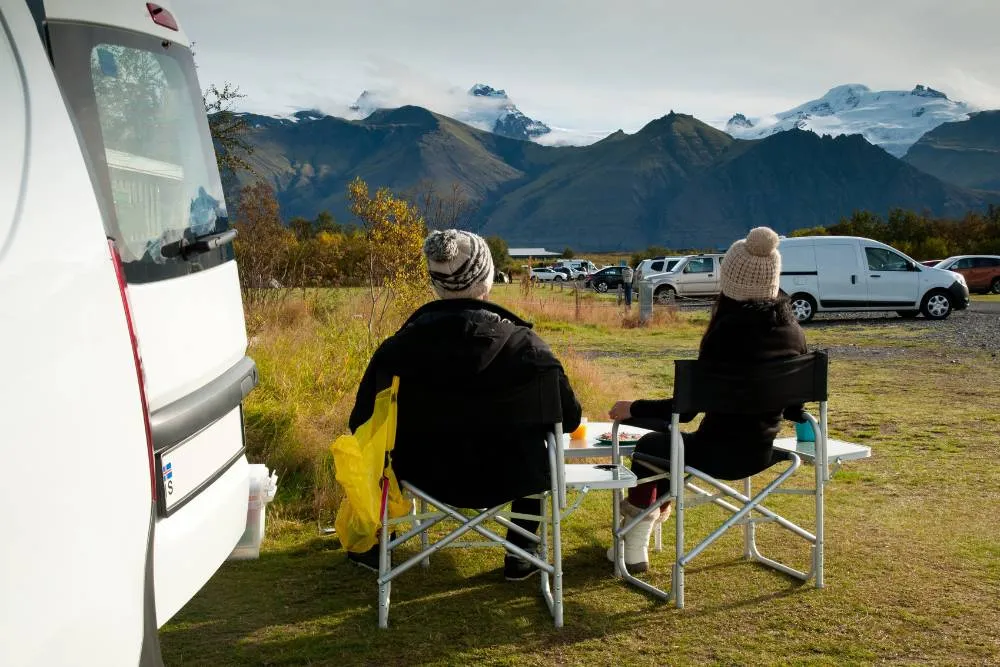Are you down for a 1,332-kilometer bike ride? — Getty Images
Iceland’s Ring Road is 1,332 kilometers (828 miles) long and is known, very directly, as Route One. It begins in Reykjavík and follows the southern coast of the island before wandering up past the Eastfjords. Entering Vatnajökull National Park, you’ll encounter the geothermal landscape of the northern part of the country. After traversing the north, you’ll return down the west coast, through the Westfjords and around the dramatic Snæfellsnes Peninsula, home to the mighty Snæfellsjökull — a glacier-topped volcano — before returning to the capital.
How long does it take to bike the Ring Road?
It takes between ten days and two weeks to cycle the Ring Road, but many people who’ve done it recommend setting aside three weeks or even a month to really see everything you want to. The road is paved the entire way, meaning you don’t need any massively specialized equipment or skills, but a reasonable level of fitness wouldn’t go amiss.
How to get your bike to Iceland
With a bit of judicious juggling, you can save on hold luggage by packing everything you need into your bike box or bag, removing the need to pay for hold luggage on your flight as well as the bike. Depending on which airport you fly into, there are a couple of options upon arrival as well.
Buses from Reykjavík Airport are fairly used to people lugging bike boxes on board, so you can head — with only minor grunting and awkwardness — into the capital before reassembling your bike.
Renting a bike for the Iceland Ring Road
There are a few places to rent bicycles in Reykjavík, such as Iceland Bike, which has a selection of road bikes, tourers, mountain bikes, and even tandems available from around 4,400 kr. (€29) per day for periods of up to a month (price for long-term rentals on request).
Where to stay
The Ring Road passes through most of Iceland’s towns. Reykjavík we’ve already mentioned, but you’ll also pass through Vík, Egilsstaðir, Akureyri, Borgarnes, and a few more. These aren’t big places — it’s not a very populated country — but each town will have at least a small selection of hotels, guest houses, B&Bs or chalets in which to stay.
However, you’ll most likely find yourself camping. Campsites are common, inexpensive, usually have at least hot showers and electricity, and some (particularly in the north) may have geothermal springs as well. The other bonus is location — many are sited in the most spectacular scenery the country has to offer, and you may find yourself falling asleep in a volcanic valley with the northern lights swirling silently overhead.
When to go
There are two factors that will determine the best time to cycle the Ring Road: weather and availability of places to stay. Thankfully, the two go pretty much hand in hand.
Iceland’s campsites are usually open only between March and September, so that gives you a pretty solid clue about when the weather’s mild enough to make the trip.
It’s not just the weather, either. In winter, days are short, with as little as four hours of daylight. There’s no point arriving to cycle a mere four hours a day, then not being able to see anything for the remaining 20 — not to mention that cycling on dark roads in the back of beyond is a foolhardy thing to do.
So, in short: summer.
What’s the weather like?
As mentioned above, in winter, the whole endeavor is pretty pointless. Spring is not hugely better, but at least you’ll have places to stay.
From late May, things improve. The weather can still be unpredictable — dreadful rain and thunderstorms are not unknown even in July and August — but the odds are with you for a good trip. You’ll also definitely not be worrying about not having enough daylight; there’s almost 24 hours of sunlight in the summer, meaning you’ve got time to eat up the miles, stop and see the sights, and no fading light while you’re putting up your tent.
What to see and do
There’s not enough space on this website to list everything you’ll encounter on your journey, so here are some selected highlights.
Waterfalls. Iceland’s waterfalls (including Dettifoss, Europe’s most thunderously powerful) are genuinely awesome, and something of a collecting exercise for Iceland lovers. Gotta see them all!Glaciers. The east and the north of the country feature the largest on the island, with Vatnajökull being the biggest of all.Beaches. It might not be swimming weather unless you’re very brave, but the south coast has some spectacular beaches stretching empty miles along the water, including the black sands of Diamond Beach.Volcanoes. North Iceland is home to most of the country’s active volcanic systems, giving rise to steaming craters, towers of basalt, and the black lava fortress of Dimmuborgir.Hot springs. After a day’s hard riding, what better way to ease those aching legs than by immersing yourself in healthy, healing, hot spring waters? An example is the Mývatn Nature Baths, a hot spring resort and spa that’s the northern equivalent of the south’s famous Blue Lagoon.How much does biking the Ring Road cost?
You’ll probably eat and drink whatever you can take with you, so coffee, oatmeal, bread, cereal bars and the like will sustain you outside the towns. Service centers (see Other tips below) are useful for basics on the go, and on a basic diet (with the odd pizza in a restaurant as a reward), you can probably do the Ring Road on, say, €350 for a two-week trip.
Hotels can be pricey. Although you’ll probably get breakfast, a double room in somewhere like Vík may well cost upwards of €160 per night, so you might want to treat these occasional stops as a luxury rather than something to be relied on in every town.
As a rough guide, for food, campsite costs, the odd overnight hotel stay, plus some miscellaneous bits and pieces, set aside around €600 — €700 (excluding flights and bike transportation) for a two- to three-week trip. Of course, if you’re renting your bike, you’ll have to add that daily cost on top.
Is it safe?
Although nothing can ever be called 100% safe, cycling in Iceland is not a massively risky undertaking as long as you’re prepared. We’ll look at equipment in a second, but what other things should you consider?
Well, the Ring Road is paved along its entire length, and excellently maintained, so unless you want to go off-grid a bit, you shouldn’t have to worry about any major incidents while cycling.
Wildlife is friendly; you’ll only encounter the odd inquisitive pony or flock of puffins, and there aren’t even any mosquitoes to worry about.
Iceland is also the safest country in Europe, if not the world, ranking number one in the Global Peace Index. Crime is virtually non-existent, particularly outside Reykjavík (although lock your bike in the capital, there’s the odd petty theft), and people are friendly.
What equipment do you need to cycle the Ring Road?A bike, obviously. Something reliable and comfortable, and with suitable tires if you want to go off the paved Ring Road and onto the gravel tracks.A basic repair kit. Tires, inner tubes, a pump and whichever spanners/hex wrenches (Allen keys) you need.Lights and reflectors. Both are legal requirements, and it might be useful to take reflective clothing as well.A helmet. Although not a legal requirement for adults, wear a helmet. It’s stupid not to.A charged phone. Internet coverage is excellent, even in remote areas, so having a map/GPS on you is always a good idea.A variety of clothes. As mentioned, Iceland’s weather can be erratic, so thin layers that can be easily taken on and off are the order of the day, as well as a waterproof top layer.A tent. You’ll need it.Other tips for cycling Iceland’s Ring RoadSubmit your travel plan to Safetravel. This is a website specifically designed for people visiting Iceland, and it works so that the authorities can keep track of your journey; in the event of you getting lost, stuck, injured or having any other problem, they’ll send help. The Safetravel.is app is also useful, giving live weather reports and updates on road conditions across the country.Make the most of service centers. These are small outposts dotted along the Ring Road that usually just consist of a petrol station and a small hut, but will give you the chance to warm up, grab a cup of coffee and a hot dog, and use the bathroom before you move on.If you’re in a group, cycle in single file, and on the right.Do not leave the roads. Whether on the Ring Road or the gravel roads of the interior, stay on the roads. Off-road travel is illegal in order to protect the delicate landscape of the country, and you risk damaging your equipment, the ecosystem, yourself, or all three. On top of that, you’ll get a large fine if you’re caught.@kiwi.com @Sabina | travel + food got a cheap travel hack you didn’t even know you needed: http://Kiwi.com Anytime search ✈️ = 💰saved #iceland #icelandtravel #icelandtrip #budgettravel #traveltiktok #traveltheworld #budgettraveler #travelblogger #cheaptravel #travelhack ♬ FEEL THE GROOVE – Queens Road, Fabian Graetz
Overall, however, cycling Iceland’s Ring Road is a wonderful, once-in-a-lifetime adventure, and as long as you use your common sense, you’ll have a wonderful time in one of the most spectacular countries on earth. Happy riding!
Visit Kiwi.com Stories for more travel inspiration.
Source link : https://www.kiwi.com/stories/cycling-the-ring-top-tips-for-biking-icelands-ring-road/
Author :
Publish date : 2023-03-01 08:00:00
Copyright for syndicated content belongs to the linked Source.

